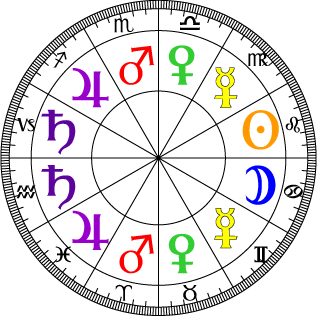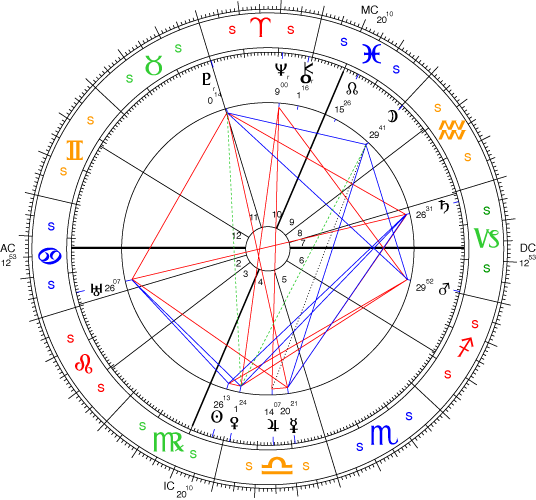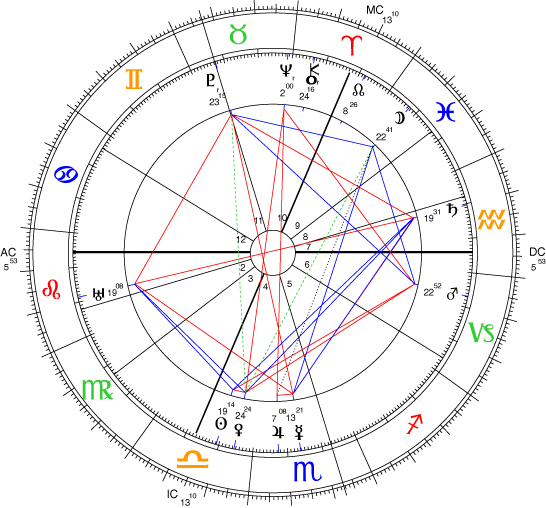No. 12, Vol. 2. Vernal Equinox 2007

Against Sidereal Astrology
or
“Zodiac? What Zodiac?”
by Alex Sumner
The Traditional
Rulerships of the Signs of the Zodiac
The assignment of Planets to the Signs of the Zodiac, over which they
rule, in the traditional fashion, may be explained thus. Each of the classical
planets of astrology, apart from the “Two Luminaries” (the
Sun and the Moon), rules over two Signs: a “Day sign” and
a “Night sign”. The two Luminaries only rule one sign each,
i.e. the Moon rules Cancer, whilst Leo rules the Sun. Apart from these
two, the rest of the planets are assigned to the signs in order from the
fastest moving (Mercury) to the slowest (Saturn). Figure 1 illustrates
this scheme (see below).
Table 1: The traditional
method of establishing planetary rulers in tropical astrology.

Figure 1: Note how
the planets are in order on each side, from Saturn to Mercury.

It is clear that the scheme is based upon the two luminaries: the rest of planets are assigned in relation thereto. The question thus becomes: why are the luminaries assigned to Cancer and Leo in the first place? Because in the Northern hemisphere, July-August is the height of Summer, and therefore is assigned the greater Luminary (the Sun); whilst the beginning of Summer, June-July, is assigned the second Luminary (the Moon). This inevitably means that Saturn, being perceived as a cold and distant planet, also rules the coldest parts of the year: December to January and January to February. One may also point out that because Mercury and Venus, which are always astrologically to be found within 30º of the Sun, it is logical to assign their rulerships to the next nearest signs to the luminaries. Viewed in this way, the traditional method of assigning planets to domicile-signs can be seen as an intuitive, sensible, and consistent method, based upon the Seasons of the Northern hemisphere.
The Precession of the Equinoxes.If the terrestrial equator is projected on the heavens – i.e. to form the “Celestial Equator”, it will be found that the annual path of the Sun – the “Ecliptic” intersects the Celestial Equator twice a year. These are the “Equinoxes”: the Vernal (i.e. Spring) equinox, when the Sun crosses the Equator from south to north (the “Spring Point”), on March 21st; and the Autumnal equinox, when the Sun crosses the Equator from north to south, on September 21st.
In tropical (i.e. traditional) astrology, the Vernal and Autumnal Equinoxes
also mark the point where the Sun enters Aries and Libra; i.e. reaches
0º Aries and 0º Libra respectively.
However, since the time of Hipparchus, astrologers have been aware that
the Spring Point does not correspond to the astronomical constellation of
Aries. Instead it is moving backwards (i.e. “preceding”) through
the Zodiac at the rate of 50.3” of arc every year (or 1º every
71.6 years). Thus instead of being near Aries, it is now towards the western
end of the constellation of Pisces, slowly approaching Aquarius. As of the
Vernal Equinox 2007, the Spring Point will be closest to the star Omega-Piscium.[1]
Whilst we are living in the so-called Age of Pisces therefore, an ever-increasing majority will find that their astronomical horoscopes differ from their tropical horoscopes by a whole Zodiacal sign. When we enter the Age of Aquarius, their will start to be an increasing number of people whose horoscopes differ by two signs. For example: Aleister Crowley (for no other reason than the author happens to know Crowley’s time, date and place of birth). Born 12th October 1875, at 11.30 P.M. in Leamington Spa, England. According to Tropical astrology, this would make him Sun in Libra, with Leo rising. However if one were to have viewed the actual stars at his time of birth, one would have observed that the Sun was in Virgo, with Cancer rising.
It was for this reason – the disparity of the signs of the zodiac between tropical astrology and astronomy, that “Sidereal Astrology” was established. A form of Sidereal Astrology has been regularly practised in India for several thousand years up to the present day, where it is known as “Jyotisha” (in the West it is referred to as “Vedic Astrology”). Western Sidereal Astrology however has been pioneered in public since 1944,[2] when it was first introduced by the astrologer Cyril Fagan.[3]Fagan’s system of Sidereal Astrology involves correcting the positions of the planets as determined by tropical astrology, so that they form a closer approximation to the astronomically-observed heavens. Note it will never be exact per se, because the astrological notion of the Zodiac is itself only an approximation of the constellations lying on the path of the Ecliptic. For example: the Zodiac is divided into 12 equal signs of 30º each: but in reality, the constellations vary enormously in size – Leo is a relatively large constellation, and Aries is relatively small.
Sidereal Astrology therefore takes certain actual stars – usually
the brightest observable ones – and declares that they correspond
to certain positions in the Zodiac. E.g. Regulus, in the constellation
of Leo, is taken to be 5º of the Zodiacal sign of Leo. By aligning
the Zodiac thus, the planets can be plotted on the horoscope in relation
to the positions of the sidereal-markers.
In practical terms, the calculation to be made is quite simple, as most
modern ephemerides publish the degree-correction which should be deducted
from each of the planet’s positions. This is referred to as the
Synetic Vernal Point (“SVP”), i.e. the position of the Spring
Point corrected according to the above procedure. For example at midday
on March 21st 2007, the SVP will be at 5º 12’ 2” of Pisces,
meaning that anyone born at that particular time will have to deduct 24º
47’58” from the positions of each of their planets and angles
if worked out according to tropical astrology, in order to calculate a
“Sidereal horoscope”
Going back to our former example, Aleister Crowley, we can now compare
his tropical horoscope with his sidereal horoscope. We should expect the
planets and the angles of the chart (Ascendant, Midheaven etc) to be in
the same positions relative to one another, but the signs that they fall
in will be completely different.
Figure 2: Aleister
Crowley's sidereal chart.

Figure 3: Aleister
Crowley's tropical chart.

There are two general differences between the charts. The sidereal chart
shows a large number of planets in the Cardinal signs, and the element
of Air. The tropical chart however shows a large number of planets in
the fixed signs … but the elements are more evenly distributed.
The Paradox
We now arrive at what the present author considers to be a major stumbling
block for Sidereal Astrology, of the kind advanced by Fagan. It is this:
In interpreting Sidereal Astrology, the signs of the Zodiac move through the year over the course of ages. However, so, apparently, do the planetary rulerships!
You will recall that we observed at the start the Planetary Rulers are mainly based on the seasons – the Sun and Moon, the two luminaries, representing Summer, and Saturn, cold and distant, representing Winter.
However, according to the Precession of the Equinoxes, the sidereal signs of Capricorn and Aquarius (traditionally ruled over by Saturn) no longer represent the depths of winter, but late winter or early spring. Whilst the sidereal signs of Cancer and Leo no longer represent the height of Summer, but late Summer and early Autumn.
Hence, if both the ideas of “the Precession of the Equinoxes” and “the Planetary Rulerships” were to be incorporated into Astrology in a strictly logical manner, then the Signs would no longer be associated with their respective rulers, but be worked out separately. The Planets would still rule over the same parts of the year, but over the course of aeons, they would be ruling over different signs of the zodiac.
I must presume that this notion has not been taken up more widely before now because it complicates things a great deal. For a start, following this logical approach, one would have to rethink and redefine the traditional meanings of the signs. For example, were we in the Age of Aquarius completely, the signs, according to the approach I suggest, would be something like this:
Table 2: Aquarian Age Zodiac: Signs adjusted sidereally, planetary rulerships established by traditional method.

A Post-Modern
Viewpoint
If one were to follow this line of thought to its logical conclusion,
it necessarily follows that over the course of aeons, that Sidereally
speaking, all points of the year have been or will be represented by all
signs of the Zodiac. However, if we accept the fact that planetary rulerships
are determined by seasons, then by the same token, over the course of
aeons, the rulerships remain constant for their respective parts of the
year. Thus from a post-modern viewpoint, the actual sign, its triplicity
(Fire, Earth, Air or Water) and its quadruplicity (Cardinal, Fixed or
Mutable) become irrelevant to consideration of a person or event in question.
Instead they are more indicative of the nature of the aeon in which the
event happens, or the person is born.
Instead the true characteristics which are idiosyncratic to the person are the planetary influences, not the elemental or quadruplicity influence of a given sign of the zodiac. For example, a person born in late November or early December two thousand years ago would Sidereally be a Sagittarius (mutable Fire); if born at the same time today, a Scorpio (Fixed Water); and if born in approximately two thousand[4] years time, would be a Libra. However, given that Planetary influences are based on seasons, these three people from different ages would each have been born under the influence of the planet Jupiter.
On this basis, a “post-modern” Zodiac which is correct for every age throughout history can be put forward:
Table 3: Post-Modern Zodiac

“Positive” and “Negative” refer to the esoteric notion of polarity (Day and Night, masculine and feminine, etc). They are neither good nor bad in themselves. Although some signs of the Zodiac have traditionally been given unpleasant characteristics,[5] in fact there is good and bad in every sign.
Hence: Mars-Positive represents leadership and determination in its “good” aspect, but belligerence and obstinacy in its “bad aspect” (analogy with Aries). On the other hand, Mars-Negative represents an energetic pursuit of the feminine side of one’s nature in its “good” aspect, but secrecy and destructive (or self-destructive) traits in its “bad” aspect (analogy with Scorpio). The meanings of the other ten “Post-Modern Zodiacal signs” can also be similarly determined by analogy.
Thus to go back to our example of Aleister Crowley – we can now express the positions of his zodiac in this so-called Post-Modern fashion.
Table 4: Aleister Crowley's Post-Modern Horoscope.

The Conclusion (or:
“Back to the Beginning.”)
Hence by focussing purely on the planetary nature of Astrology, and by
taking a long-term post-modern point of view, it is possible to render
the whole business of the precession of the equinoxes, and the innovations
to traditional western astrology of Sidereal Astrology, largely redundant.
Phases of Celestial Activity – which would formerly have been called
“Signs of the Zodiac” – should be analysed first in
terms of the planetary influences which govern them. Their elemental or
quadruplicity influences should either be ignored, or re-interpreted as
particular characteristics applying to that phase of celestial activity
throughout that age of history.
There is one problem which the author acknowledges with the “post-modern” nomenclature of “Mars-Positive”, “Venus-Negative” etc proposed above: it is hardly catchy! What if therefore a set of twelve names were to be found for them which had more popular appeal – the epithets of “Mars-Positive” etc being consigned their description only?
If one starts thinking like this, it is but one step to just simply calling them “Aries”, “Taurus”, “Gemini” etc: albeit with the proviso that these names are in no way connected with the corresponding constellations. This is effectively the same argument that modern astrologers use to justify the continued use of Tropical Astrology. However, I am not proposing an unquestioning return to Tropical Astrology per se, merely that it be re-evaluated for modern times in terms of planetary influences, and less-so for elemental and quadruplicity influences.
Bibliography
FAGAN, C., FIREBRACE, R., 1971. The Primer of Sidereal Astrology. Temple: AZ. American Federation of Astrologers,
LILLY, W. “Zadkiel” (ed.), 1852. An Introduction to Astrology. London: G. Bell.
REGARDIE, I., 1989. The Golden Dawn. St. Paul, MN: Llewellyn.
WRIGHT, A [n.d.], 2005. The Fixed Stars. [Online]. Available: http://users.winshop.com.au/annew/Pisces.html [5th March 2007].
Notes
[1] http://users.winshop.com.au/annew/Pisces.html
[2] Although a form of Sidereal Astrology had been practiced privately by at least one organisation, the Hermetic Order of the Golden Dawn. This however differed significantly from Fagan’s version: for example, Regulus was reckoned to be 0º Leo, whereas Fagan uses [Regulus = 5º Leo]. See Regardie (1989, p.594).[4] Or to be more exact, slightly more than 2147 years.
[5] E.g. Scorpio and Pisces (“Mars-Negative” and “Jupiter-Negative”) usually come in for a bad time, not least by their associations with the 8th (Death) and 12th (Deceit; Enemies in Secret) Houses respectively. Lilly (1852, pp.63 – 66) describes Scorpio as representing deceitful men, and Pisces as being effeminate and sickly.